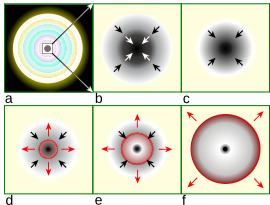Pulsar
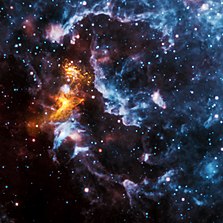

A pulsar (from pulsating radio source)
The periods of pulsars make them very useful tools for astronomers. Observations of a pulsar in a
History of observation
Discovery
Signals from the
When observations with another telescope confirmed the emission, it eliminated any sort of instrumental effects. At this point, Bell said of herself and Hewish that "we did not really believe that we had picked up signals from another civilization, but obviously the idea had crossed our minds and we had no proof that it was an entirely natural radio emission. It is an interesting problem—if one thinks one may have detected life elsewhere in the universe, how does one announce the results responsibly?"[13] Even so, they nicknamed the signal LGM-1, for "little green men" (a playful name for intelligent beings of extraterrestrial origin).
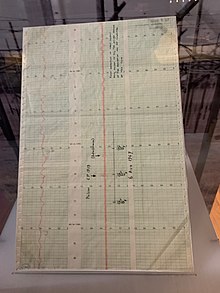
It was not until a second pulsating source was discovered in a different part of the sky that the "LGM hypothesis" was entirely abandoned.
The word "pulsar" first appeared in print in 1968:
An entirely novel kind of star came to light on Aug. 6 last year and was referred to, by astronomers, as LGM (Little Green Men). Now it is thought to be a novel type between a white dwarf and a neutron [star]. The name Pulsar is likely to be given to it. Dr. A. Hewish told me yesterday: '... I am sure that today every radio telescope is looking at the Pulsars.'[16]
The existence of neutron stars was first proposed by Walter Baade and Fritz Zwicky in 1934, when they argued that a small, dense star consisting primarily of neutrons would result from a supernova.[17] Based on the idea of magnetic flux conservation from magnetic main sequence stars, Lodewijk Woltjer proposed in 1964 that such neutron stars might contain magnetic fields as large as 1014 to 1016 gauss (=1010 to 1012 tesla).[18] In 1967, shortly before the discovery of pulsars, Franco Pacini suggested that a rotating neutron star with a magnetic field would emit radiation, and even noted that such energy could be pumped into a supernova remnant around a neutron star, such as the Crab Nebula.[19] After the discovery of the first pulsar, Thomas Gold independently suggested a rotating neutron star model similar to that of Pacini, and explicitly argued that this model could explain the pulsed radiation observed by Bell Burnell and Hewish.[20] In 1968, Richard V. E. Lovelace with collaborators discovered period ms of the Crab Nebula pulsar using Arecibo Observatory.[21][22] The discovery of the
Milestones

In 1974,
In 1982,

In 1992,
In 2016, AR Scorpii was identified as the first pulsar in which the compact object is a white dwarf instead of a neutron star.[31] Because its moment of inertia is much higher than that of a neutron star, the white dwarf in this system rotates once every 1.97 minutes, far slower than neutron-star pulsars.[32] The system displays strong pulsations from ultraviolet to radio wavelengths, powered by the spin-down of the strongly magnetized white dwarf.[31]
Nomenclature
Initially pulsars were named with letters of the discovering observatory followed by their right ascension (e.g. CP 1919). As more pulsars were discovered, the letter code became unwieldy, and so the convention then arose of using the letters PSR (Pulsating Source of Radio) followed by the pulsar's right ascension and degrees of declination (e.g. PSR 0531+21) and sometimes declination to a tenth of a degree (e.g. PSR 1913+16.7). Pulsars appearing very close together sometimes have letters appended (e.g. PSR 0021−72C and PSR 0021−72D).
The modern convention prefixes the older numbers with a B (e.g. PSR B1919+21), with the B meaning the coordinates are for the 1950.0 epoch. All new pulsars have a J indicating 2000.0 coordinates and also have declination including minutes (e.g. PSR J1921+2153). Pulsars that were discovered before 1993 tend to retain their B names rather than use their J names (e.g. PSR J1921+2153 is more commonly known as PSR B1919+21). Recently discovered pulsars only have a J name (e.g. PSR J0437−4715). All pulsars have a J name that provides more precise coordinates of its location in the sky.[33]
Formation, mechanism, turn off

The events leading to the formation of a pulsar begin when the core of a massive star is compressed during a supernova, which collapses into a neutron star. The neutron star retains most of its angular momentum, and since it has only a tiny fraction of its progenitor's radius (and therefore its moment of inertia is sharply reduced), it is formed with very high rotation speed. A beam of radiation is emitted along the magnetic axis of the pulsar, which spins along with the rotation of the neutron star. The magnetic axis of the pulsar determines the direction of the electromagnetic beam, with the magnetic axis not necessarily being the same as its rotational axis. This misalignment causes the beam to be seen once for every rotation of the neutron star, which leads to the "pulsed" nature of its appearance.
In rotation-powered pulsars, the beam is the result of the
Though the general picture of pulsars as rapidly rotating neutron stars is widely accepted, Werner Becker of the Max Planck Institute for Extraterrestrial Physics said in 2006, "The theory of how pulsars emit their radiation is still in its infancy, even after nearly forty years of work."[39]
Categories
Three distinct classes of pulsars are currently known to astronomers, according to the source of the power of the electromagnetic radiation:
- rotation-powered pulsars, where the loss of rotational energy of the star provides the power,
- accretion-powered pulsars (accounting for most but not all X-ray pulsars), where the gravitational potential energy of accretedmatter is the power source (producing X-rays that are observable from the Earth),
- magnetars, where the decay of an extremely strong magnetic field provides the electromagnetic power.
Although all three classes of objects are neutron stars, their observable behavior and the underlying physics are quite different. There are, however, some connections. For example, X-ray pulsars are probably old rotationally-powered pulsars that have already lost most of their power, and have only become visible again after their binary companions had expanded and begun transferring matter on to the neutron star.
The process of accretion can, in turn, transfer enough angular momentum to the neutron star to "recycle" it as a rotation-powered millisecond pulsar. As this matter lands on the neutron star, it is thought to "bury" the magnetic field of the neutron star (although the details are unclear), leaving millisecond pulsars with magnetic fields 1000–10,000 times weaker than average pulsars. This low magnetic field is less effective at slowing the pulsar's rotation, so millisecond pulsars live for billions of years, making them the oldest known pulsars. Millisecond pulsars are seen in globular clusters, which stopped forming neutron stars billions of years ago.[38]
Of interest to the study of the state of the matter in a neutron star are the

Disrupted recycled pulsar
When two massive stars are born close together from the same cloud of gas, they can form a binary system and orbit each other from birth. If those two stars are at least a few times as massive as the Sun, their lives will both end in supernova explosions. The more massive star explodes first, leaving behind a neutron star. If the explosion does not kick the second star away, the binary system survives. The neutron star can now be visible as a radio pulsar, and it slowly loses energy and spins down. Later, the second star can swell up, allowing the neutron star to suck up its matter. The matter falling onto the neutron star spins it up and reduces its magnetic field.
This is called "recycling" because it returns the neutron star to a quickly-spinning state. Finally, the second star also explodes in a supernova, producing another neutron star. If this second explosion also fails to disrupt the binary, a double neutron star binary is formed. Otherwise, the spun-up neutron star is left with no companion and becomes a "disrupted recycled pulsar", spinning between a few and 50 times per second.[40]
Applications
The discovery of pulsars allowed astronomers to study an object never observed before, the neutron star. This kind of object is the only place where the behavior of matter at nuclear density can be observed (though not directly). Also, millisecond pulsars have allowed a test of general relativity in conditions of an intense gravitational field.
Maps
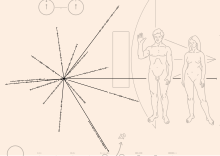
Pulsar maps have been included on the two
X-ray pulsar-based navigation and timing (XNAV) or simply pulsar navigation is a navigation technique whereby the periodic
Precise clocks
Generally, the regularity of pulsar emission does not rival the stability of
For example, J0437−4715 has a period of 0.005757451936712637 s with an error of 1.7×10−17 s. This stability allows millisecond pulsars to be used in establishing ephemeris time[50] or in building pulsar clocks.[51]Timing noise is the name for rotational irregularities observed in all pulsars. This timing noise is observable as random wandering in the pulse frequency or phase.[52] It is unknown whether timing noise is related to pulsar glitches. According to a study published in 2023,[53] the timing noise observed in pulsars is believed to be caused by background gravitational waves. Alternatively, it may be caused by stochastic fluctuations in both the internal (related to the presence of superfluids or turbulence) and external (due to magnetospheric activity) torques in a pulsar.[54]
Probes of the interstellar medium
The radiation from pulsars passes through the interstellar medium (ISM) before reaching Earth. Free electrons in the warm (8000 K), ionized component of the ISM and H II regions affect the radiation in two primary ways. The resulting changes to the pulsar's radiation provide an important probe of the ISM itself.[55]
Because of the
where is the distance from the pulsar to the observer, and is the electron density of the ISM. The dispersion measure is used to construct models of the free electron distribution in the Milky Way.[56]
Additionally, density inhomogeneities in the ISM cause
Probes of space-time
Pulsars orbiting within the curved
Gravitational wave detectors
There are four consortia around the world which use pulsars to search for
Significant pulsars
| PSR | Distance (pc) |
Age ( Myr )
|
|---|---|---|
| J0030+0451 | 244 | 7,580 |
| J0108−1431 | 238 | 166 |
| J0437−4715 | 156 | 1,590 |
| J0633+1746 | 156 | 0.342 |
| J0659+1414 | 290 | 0.111 |
| J0835−4510 | 290 | 0.0113 |
| J0453+0755 | 260 | 17.5 |
| J1045−4509 | 300 | 6,710 |
| J1741−2054 | 250 | 0.387 |
| J1856−3754 | 161 | 3.76 |
| J2144−3933 | 165 | 272 |
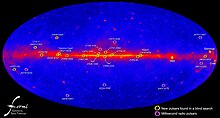
The pulsars listed here were either the first discovered of its type, or represent an extreme of some type among the known pulsar population, such as having the shortest measured period.
- The first radio pulsar "CP 1919" (now known as PSR B1919+21), with a pulse period of 1.337 seconds and a pulse width of 0.04-second, was discovered in 1967.[7]
- The first gravitational radiation at the exact rate predicted by general relativity.
- The brightest radio pulsar, the Vela Pulsar.
- The first millisecond pulsar, PSR B1937+21
- The brightest millisecond pulsar, PSR J0437−4715
- The first Cen X-3
- The first accreting millisecond X-ray pulsar, SAX J1808.4−3658
- The first pulsar with planets, PSR B1257+12
- The first pulsar observed to have been affected by asteroids: PSR J0738−4042
- The first double pulsar binary system, PSR J0737−3039
- The shortest period pulsar, PSR J1748−2446ad, with a period of ~0.0014 seconds or ~1.4 milliseconds (716 times a second).
- The longest period neutron star pulsar, PSR J0901-4046, with a period of 75.9 seconds.
- The longest period pulsar, at 118.2 seconds, as well as one of the only known two white dwarf pulsars, AR Scorpii.[63]
- The first white dwarf pulsar AE Aquarii.[64][65]
- The pulsar with the most stable period, PSR J0437−4715
- The first millisecond pulsar with 2 stellar mass companions, PSR J0337+1715
- PSR J1841−0500, stopped pulsing for 580 days. One of only two pulsars known to have stopped pulsing for more than a few minutes.
- PSR B1931+24, has a cycle. It pulses for about a week and stops pulsing for about a month.[66] One of only two pulsars known to have stopped pulsing for more than a few minutes.
- Swift J0243.6+6124 most magnetic pulsar with 1.6×1013 G.[67][68]
- PSR J1903+0327, a ~2.15 ms pulsar discovered to be in a highly eccentric binary star system with a Sun-like star.[71]
- PSR J2007+2722, a 40.8-hertz 'recycled' isolated pulsar was the first pulsar found by volunteers on data taken in February 2007 and analyzed by distributed computing project Einstein@Home.[72]
- PSR J1311–3430, the first millisecond pulsar discovered via gamma-ray pulsations and part of a binary system with the shortest orbital period.[73]
Gallery
-
Video – Crab Pulsar – bright pulse and interpulse.
-
Video –Vela pulsar – X-ray light.
-
Video – Artist's impression of AR Scorpii.
See also
References
- ^ "Definition of PULSAR". www.merriam-webster.com. 31 May 2023.
- ^ "NASA's NICER Delivers Best-ever Pulsar Measurements, 1st Surface Map". 11 December 2019.
- ^ Sullivan, Walter (February 9, 1983). "PULSAR TERMED MOST ACCURATE 'CLOCK' IN SKY". NY Times. The New York Times. Retrieved January 15, 2018.
- ^ Proudfoot, Ben (July 27, 2021). "She Changed Astronomy Forever. He Won the Nobel Prize For It - In 1967, Jocelyn Bell Burnell made an astounding discovery. But as a young woman in science, her role was overlooked". The New York Times. Retrieved July 27, 2021.
- ^ "I Changed Astronomy Forever. He Won the Nobel Prize for It. | 'Almost Famous' by Op-Docs". YouTube.
- ^ a b Hewish, A., Bell, S. J., et al. "Observation of a Rapidly Pulsating Radio Source Archived 2021-08-04 at the Wayback Machine". Nature, Volume 217, 1968 (pp. 709–713).
- S2CID 4277613.
- ^ George Hobbs; Simon Johnston (November 28, 2017). "Fifty years ago, Jocelyn Bell discovered pulsars and changed our view of the universe". phys.org. Retrieved August 4, 2021.
{{cite journal}}: Cite journal requires|journal=(help) - ^ Pranab Ghosh, Rotation and accretion powered pulsars. World Scientific, 2007, p. 2.
- ^ M. S. Longair, Our evolving universe. CUP Archive, 1996, p. 72.
- ^ M. S. Longair, High energy astrophysics, Volume 2. Cambridge University Press, 1994, p. 99.
- ^ S. Jocelyn Bell Burnell (1977). "Little Green Men, White Dwarfs or Pulsars?". Cosmic Search Magazine. Retrieved 2008-01-30. (after-dinner speech with the title of Petit Four given at the Eighth Texas Symposium on Relativistic Astrophysics; first published in Annals of the New York Academy of Science, vol. 302, pp. 685–689, Dec. 1977).
- PMID 15105461.
- ^ Courtland, Rachel. "Pulsar Detected by Gamma Waves Only Archived 2015-07-02 at the Wayback Machine". New Scientist, 17 October 2008.
- ^ Daily Telegraph, 21/3, 5 March 1968.
- .
- doi:10.1086/148028.
- S2CID 4282721.
- S2CID 4217682.
- ^ Crab nebula pulsar NP 0532 Archived 2020-11-19 at the Wayback Machine 1969, J. M. Comella, H. D. Craft, R. V. E. Lovelace, J. M. Sutton, G. L. Tyler Nature 221 (5179), 453–454.
- ^ Digital Search Methods for Pulsars Archived 2021-04-20 at the Wayback Machine 1969, R. V. E. Lovelace, J. M. Sutton, E. E. Salpeter Nature 222 (5190), 231–233.
- ^ On the discovery of the period of the Crab Nebula pulsar Archived 2021-06-02 at the Wayback Machine R. V. E. Lovelace and G. L. Tyler 2012, The Observatory, 132, 186.
- ^ Lyne & Graham-Smith, pp. 1–7 (1998).
- ^ "Press Release: The Nobel Prize in Physics 1974". 15 October 1974. Retrieved 2014-01-19.
- ^ Bell Burnell, S. Jocelyn. "Little Green Men, White Dwarfs, or Pulsars?" Archived 2019-06-07 at the Wayback Machine. Annals of the New York Academy of Science, vol. 302, pp. 685–689, Dec. 1977.
- S2CID 118573183.
- ^ "Nobel Prize in Physics 1993". Retrieved 2010-01-07.
- S2CID 4247734.
- ^ ISBN 978-981-12-2093-7
- ^ S2CID 15683792.
- S2CID 4451512.
- ^ Lyne, Andrew G.; Graham-Smith, Francis. Pulsar Astronomy. Cambridge University Press, 1998.
- ^ "Pulsar Beacon Animation". Retrieved 2010-04-03.
- ^ "Pulsars". Retrieved 2010-04-03.
- ^ Arzoumanian, Zaven; Gendreau, Keith (December 2019). "Focus on NICER Constraints on the Dense Matter Equation of State". The Astrophysical Journal Letters. Retrieved 14 December 2019.
- ^ Garner, Rob (11 December 2019). "NASA's NICER Delivers Best-ever Pulsar Measurements, 1st Surface Map". NASA. Retrieved 14 December 2019.
- ^ a b "Pulsars". www.cv.nrao.edu. Archived from the original on 2020-11-12. Retrieved 2018-09-15.
- ^ "Old Pulsars Still Have New Tricks to Teach Us". Staff. ESA. 26 July 2006. Retrieved 30 April 2013.
- ^ "Einstein@Home 'citizen scientists' in the U.S.A. and Germany discover a new pulsar in Arecibo telescope data" (PDF). Albert Einstein Institut (Press release). Hannover, DE: Max Planck Institut für Gravitationsphysik. 2010-08-12. Archived from the original (PDF) on 2010-08-14. Retrieved 2010-09-23. – Background material on "disrupted recycled pulsar" PSR J2007+2722.
- ^ "Voyager – The Spacecraft". voyager.jpl.nasa.gov.
- ^ Marissa Cevallos, Science News, "How to Use a Pulsar to Find Starbucks" Archived 2012-07-31 at the Wayback Machine, Discovery News, Nov 24, 2010.
- S2CID 118704955.
- ^ Commissariat, Tushna (4 June 2014). "Pulsars map the way for space missions". Physics World.
- ^ "An Interplanetary GPS Using Pulsar Signals". MIT Technology Review. 23 May 2013. Archived from the original on 29 November 2014. Retrieved 13 March 2021.
- S2CID 118570784.
- .
- S2CID 118396798.
- Bibcode:1997A&A...326..924M. Archived from the original(PDF) on 2011-07-25. Retrieved 2010-04-03.
- S2CID 120371785. Archived from the originalon 2013-01-05. Retrieved 2010-02-14.
- ^ "World's most accurate clock to be built in Gdańsk". Polska Agencja Prasowa. 2010. Retrieved 2012-03-20.[permanent dead link]
- ^ "African Skies 4 – Radio Pulsar Glitch Studies".
- ^ "Pulsar timing irregularities reveals hidden gravitational-wave background". Physics World. 2023-06-29. Retrieved 2023-07-11.
- ISSN 0035-8711.
- S2CID 16232084.
- doi:10.1086/172870.
- .
- .
- .
- ^ S2CID 118449684.
- S2CID 14133127.
- .
- S2CID 15683792.
- Bibcode:1998A&A...338..521I.
- ISSN 0004-6264.
- ^ O'Brien, Tim. "Part-time pulsar yields new insight into inner workings of cosmic clocks | Jodrell Bank Centre for Astrophysics". www.jb.man.ac.uk. Retrieved 23 July 2017.
- S2CID 249538417.
- ^ "Astronomers measure strongest magnetic field ever detected". New Atlas. 2022-07-15. Retrieved 2022-08-22.
- ^ Croswell, Ken (2022-07-22). "The heaviest neutron star on record is 2.35 times the mass of the sun". Science News. Retrieved 2022-07-25.
- S2CID 250451299.
- S2CID 6070830.
- S2CID 29786670.
- S2CID 206544680.
Further reading
- Lorimer, Duncan R.; Kramer, Michael (2004). Handbook of Pulsar Astronomy. Cambridge University Press. ISBN 978-0-521-82823-9.
- Lorimer, Duncan R. (2008). "Binary and Millisecond Pulsars". Living Reviews in Relativity. 11 (1): 8. PMID 28179824. Archived from the originalon 2012-03-15. Retrieved 2011-12-14.
- Lyne, Andrew G.; Graham-Smith, Francis (1998). Pulsar Astronomy. Cambridge University Press. ISBN 978-0-521-59413-4.
- Manchester, Richard N.; Taylor, Joseph H. (1977). Pulsars. W. H. Freeman and Company. ISBN 978-0-7167-0358-7.
- Stairs, Ingrid H (2003). "Testing General Relativity with Pulsar Timing". Living Reviews in Relativity. 6 (1): 5. PMID 28163640.
External links
- "A Pulsar Discovery: First Optical Pulsar Archived 2007-10-03 at the Wayback Machine". Moments of Discovery, American Institute of Physics, 2007 (Includes audio and teachers guides).
- Discovery of Pulsars: Interview with Jocelyn Bell Burnell. Jodcast, June 2007 (Low Quality Version).
- Audio: Cain/Gay – Astronomy Cast. Pulsars – Nov 2009
- Australia National Telescope Facility: Pulsar Catalogue
- Johnston, William Robert. "List of Pulsars in Binary Systems". Johnston Archive, 22 March 2005.






